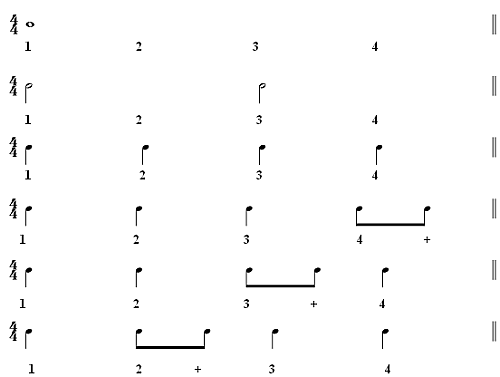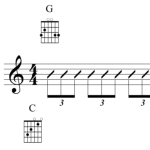A basic understanding of rhythm is crucial for all guitar players. This is true whether you play guitar for pleasure, or have much loftier goals.
When you don’t have the basics of rhythm down, you will find it much harder to play songs than it needs to be.
For example, if a chord is supposed to be played on the 4th beat and you strum it a bit late, it will sound wrong. The right notes, or chords, played at the wrong time are actually the wrong notes.
So let’s get started…
Meter
Music is usually organized in a repeatable accent pattern known as meter. The repeatable accent pattern will consist of a combination of strong and weak beats.
For example:
S = strong
W = weak
2/4 time consists of:
S W
3/4 time consists of:
S W W
4/4 time consists of:
S W M W (M stands for medium weak)
5/4 time consists of:
S W S W W
or
S W W S W
Time Values
The most common time signature, 4/4, (pronounced four-four) is often abbreviated with a fancy “C” and called common time. In 4/4, the whole note receives four beats or counts. The half note receives two beats and the quarter note receives one beat. Eighth notes each receive half of a beat.
Note Durations
Eighth notes are sometimes written without connecting beams:
The whole note receives 4 beats; the half note receives 2 beats; a quarter note receives 1 beat and an eighth note receives 1/2 of a beat; a sixteenth note receives 1/4 of a beat and each part of the triplet receives 1/3 of a beat.
Time Signatures
A time signature is used to indicate the strong and weak beats in a measure and also which note value receives one beat. In Simple Time (2/2, 2/4, 2/8, 3/2, 3/4, 3/8, 4/2, 4/4, 4/8), the top number of the time signature indicates the number of beats per measure while the bottom number indicates the type of note that receives one beat. For example:
Here are some simple examples in 4/4 for you to practice. Count these examples out loud as you clap the rhythms.
That covers the basics of rhythm. In our next post we will expand on this and apply it to the guitar.











Pingback: 7 Great Ways to Improve Your Rhythm Guitar Playing | Guitar Accelerator Blog: Play Guitar - Electric and Acoustic Guitar Lessons